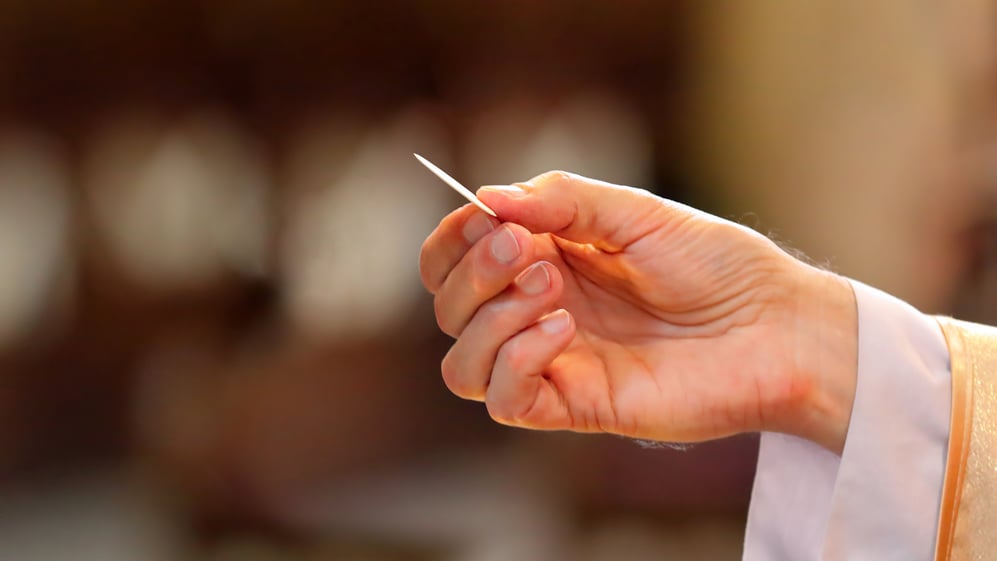When I was a child, my church always sang “Let All Mortal Flesh Keep Silence” on Christmas Day as the Communion elements were processed into the sanctuary. The congregation would start quietly and crescendo with each verse, serving to highlight the Lord’s Supper as the high point of the service. We would have the hymns printed in a bulletin, so I remember being surprised the first time I realized that this hymn is found in the Lord’s Supper section of the hymnal rather than the Christmas section.
Mortal Flesh and God’s Son
This fifth-century hymn sheds light on the significant link between the birth of Jesus and Jesus’ presence in the Lord’s Supper. The link is the two natures of Christ—the reality that Jesus is both fully God and fully man—and just “as of old on earth He stood … in human vesture,” He is also present in the bread and the wine. If it was possible for God to take on human flesh, it is also possible for Him to give Himself to the faithful in the bread and the wine.
The first verse is as follows:
Let all mortal flesh keep silence
And with fear and trembling stand;
Ponder nothing earthly-minded,
For with blessing in His hand
Christ our God to earth descending
Comes our homage to demand. (LSB 621)
These words fit perfectly on Christmas, as we remember our Lord descending to earth and being born as a baby, just as they perfectly describe our weekly encounter with our Lord at His altar as He gives us His body and blood. The second verse continues:
King of kings yet born of Mary,
As of old on earth He stood,
Lord of lords in human vesture,
In the body and the blood,
He will give to all the faithful
His own self for heavenly food.
“What does it mean that Jesus is both God and man?”
Throughout its history, the Church has honed its articulation of the relationship between Jesus’ human nature and His divine nature. In post-Reformation Germany, Martin Chemnitz wrote a lengthy work titled The Two Natures in Christ, where he spends five hundred pages compiling the Church’s response to the question “What does it mean that Jesus is both God and man?” Chemnitz’s methodology (in this work and his others) is to begin with an analysis of the applicable Scripture passages, then reference the ecumenical creeds and the church councils, before moving to an examination of the Church Fathers, and finally ending with Martin Luther’s writings and addressing current errors.
The Church Fathers, the creeds and councils, and the hymnody of the historic Church all address this question beautifully and rigorously. The brilliance of Chemnitz’s work is that he gathers together exhaustively both the scriptural witness and the witness of church history. Though he wrote this book over four hundred years ago, it is just as useful to us today in combatting various errors present in our churches and our world.
Christ’s Presence in Communion
One such error regarding the two natures in Christ is one that was held in Chemnitz’s day and is still held today by those who reject the real presence of Christ in Communion. The Calvinist argument that “the finite cannot contain the infinite,” suggests that as Jesus still has His human, resurrected body and is now seated (literally and embodied) at the right hand of God, He cannot logically be present in the bread and wine at the Communion rail.
Chemnitz thoroughly addresses this false understanding by explaining both the communication of attributes and the nature of Jesus’ kingly reign. The phrase communication of attributes references the Chalcedonian definition (a decree of the Council of Chalcedon, AD 451) that “both natures in Christ perform in communication with one another what is proper to each of them” (Chemnitz, Two Natures, 215).
We believe that there is no division or separation in the person of Christ, therefore the attributes of Jesus’ divine nature are communicated to His human nature. So while Christ has a body of flesh, He is also our all-powerful God, meaning that if He chooses to be present in His body in the Sacrament, He can do this. The divine attribute of omnipotence is communicated to the human attribute of having a body.
Chemnitz explains what comfort we can draw from this doctrine:
In this way we can see into what a high degree of dignity our human nature has been assumed by the Son of God and hence what great comfort we may draw from it. We can be sure that the work of Christ’s kingdom and priesthood belongs to us in the church, since He exercises and accomplishes this work against the gates of hell, both in the presence of the Father and toward us, not absolutely and by His divine power alone, but in, with, and through the assumed nature which is similar to ours, akin to us, and thus of the same substance with us. (Chemnitz, Two Natures, 217)
Gathered with True Body and True Blood
Because of Jesus’ humanity, we can know that He who sits on the throne of heaven is truly one of us. God is on our side, forever, and our fate is wrapped up in Him. As an act of divine power, Jesus is fully able to gather us all together into the Body of Christ, uniting us with His real, true body and blood. Chemnitz’s Two Natures may be a challenging read, but the theology expressed in its pages is full of practical comfort and assurance. What could be more wonderful for our world today than a God who reigns over all things who is also fully man? He is our perfect mediator because He is our Brother, and He is our final, certain hope because He is our Lord.
For me, Christmas Day is not complete without a trip to church to meet Jesus at His altar. Like the shepherds who went with haste to find the baby Jesus, we can also go and encounter our Savior—Immanuel, God with us—at His table.
Chemnitz quotations are from Martin Chemnitz. The Two Natures in Christ. Vol. 6 of Chemnitz’s Works. Translated by J. A. O. Preus. 1971. Reprint, St. Louis: Concordia Publishing House, 2007.
Learn more about Communion and the Lutheran beliefs surrounding it with Preparing to Receive Holy Communion.















.jpg?width=50&height=50&name=IMG_20220621_160541_456%20(1).jpg)